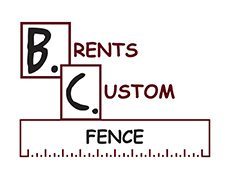Why Wood Fences Are America’s Favorite Backyard Solution
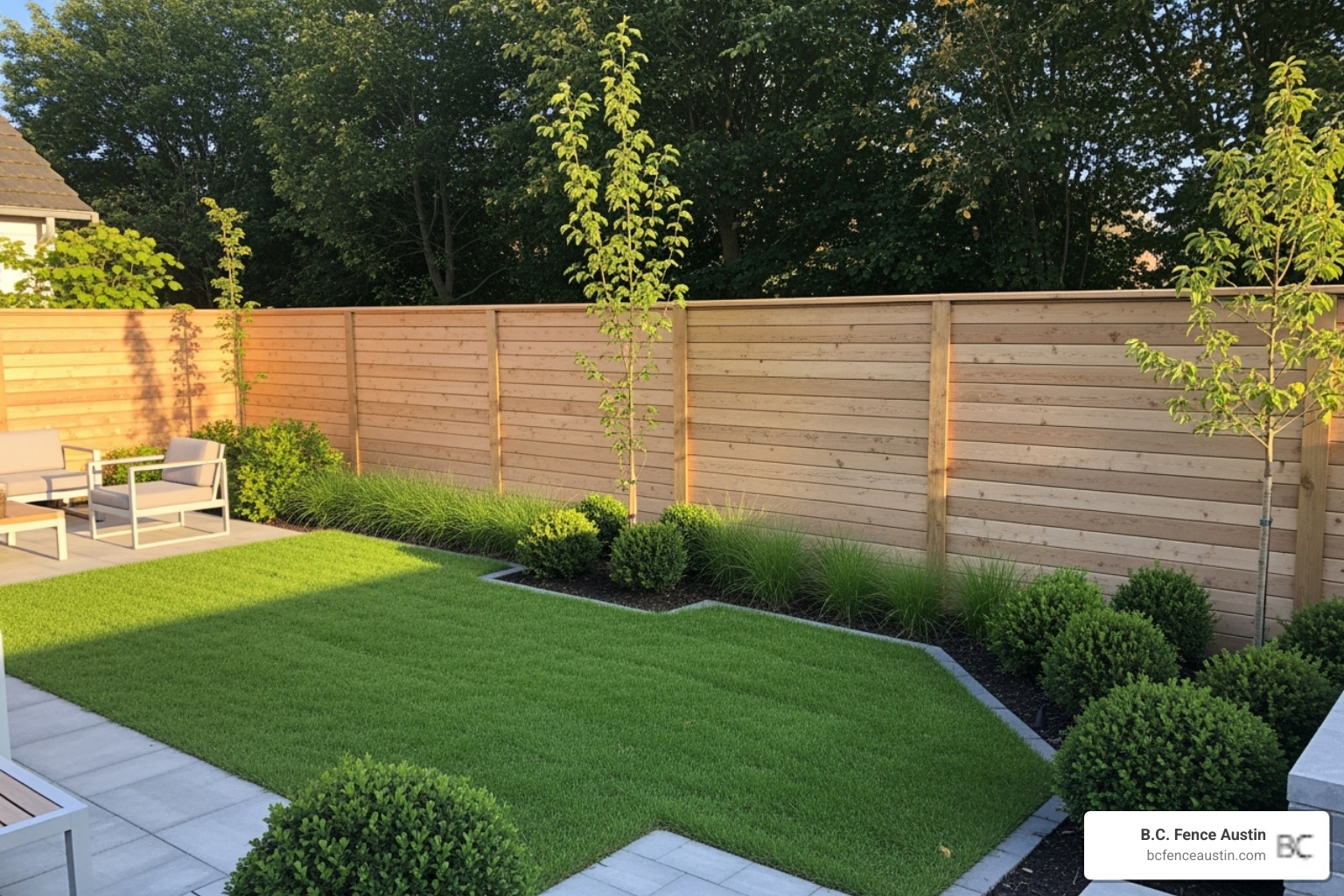
Wood fence ideas offer an unbeatable combination of beauty, privacy, and value. Whether you’re creating a secluded retreat, boosting curb appeal, or keeping kids and pets safe, wood fencing delivers.
Quick Answer: Top Wood Fence Ideas for Your Home
- For Privacy: Board-on-board, shadowbox, or horizontal slat designs
- For Curb Appeal: Classic white picket, split-rail, or Cape Cod styles
- For Modern Homes: Horizontal planks with metal accents or herringbone patterns
- For Budget-Conscious: Pressure-treated pine picket or DIY pallet fences
- For Durability: Cedar or redwood with proper staining and maintenance
Wood fences are popular because they are naturally beautiful and affordable compared to vinyl or wrought iron. With proper care, they can last 15-20 years, making them a smart investment. Wood is also a sustainable choice; as a renewable and biodegradable material, it’s more eco-friendly than vinyl and offers unlimited customization through stains and paints.
This guide explores 25 stunning wood fence ideas, from timeless picket fences to sleek horizontal designs. We’ll cover choosing the right wood, adding custom touches, and integrating landscaping for maximum impact.
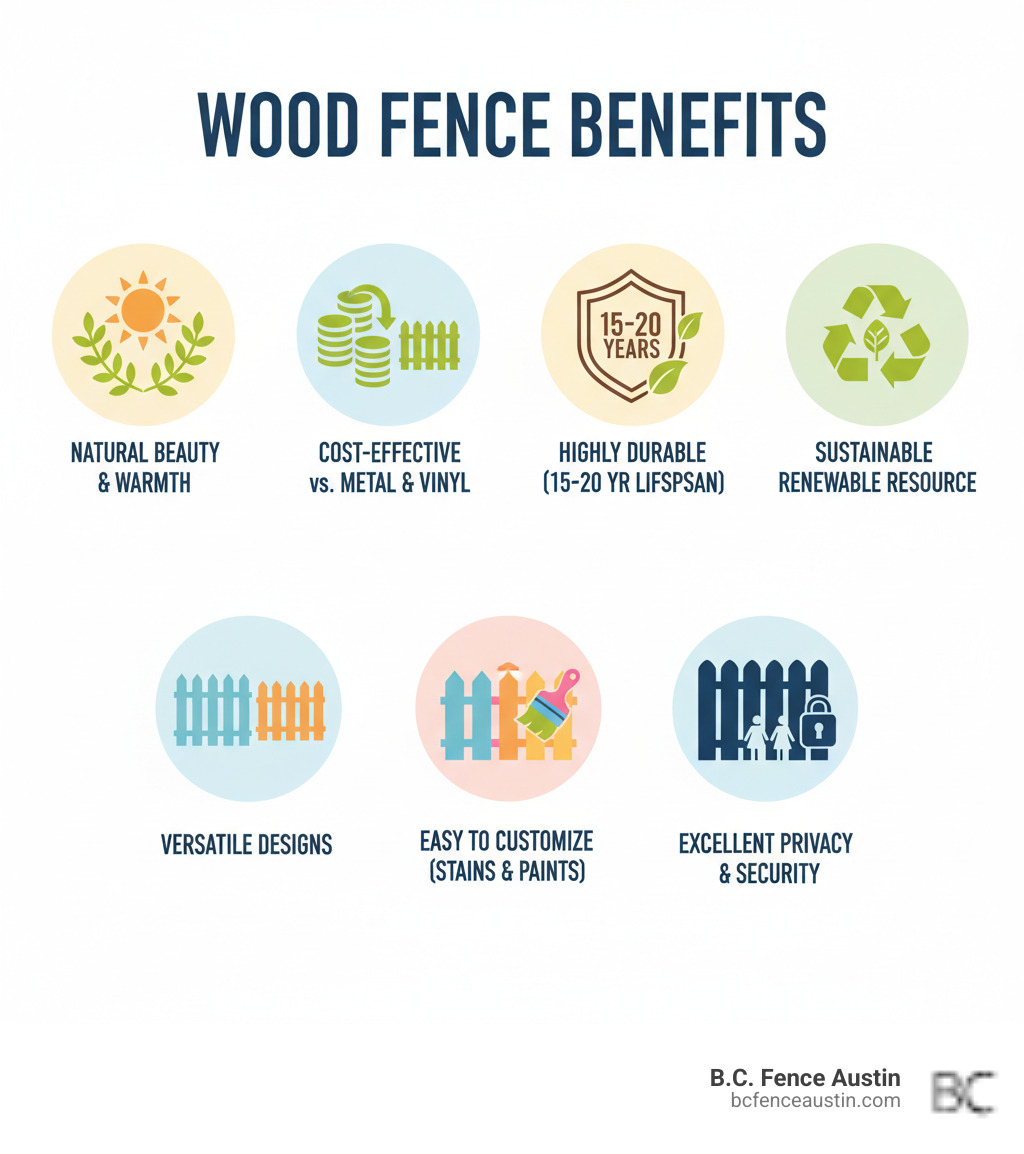
Why a Wood Fence is the Perfect Choice for Your Home
Wood fencing offers a timeless beauty that synthetic materials can’t replicate. The natural warmth and character of wood have improved homes for centuries and continue to be a gold standard for residential properties.
With proper maintenance, a quality wood fence can last 15-20 years or more. Cedar and redwood naturally resist rot and insects, while pressure-treated pine offers excellent durability at a budget-friendly price. This makes a wood fence a lasting investment in your property.
Wood is also remarkably cost-effective compared to wrought iron or composite, offering a premium look without the high price. Plus, repairs are simple and affordable, often only requiring the replacement of individual boards. For more details, see our insights on the Benefits of Wooden Fence.
As a renewable and biodegradable resource, wood is more sustainable than vinyl. Choosing FSC-certified wood supports responsible forestry, making it a choice that’s good for your home and the planet.
The versatility of wood allows for endless design possibilities. From classic picket fences to modern horizontal slats, wood can be customized to fit any aesthetic. You can stain it, paint it, or let it weather naturally, giving you complete creative control. This flexibility makes it the top choice for privacy fences, as you can tailor the height, spacing, and style to your exact needs. See how we can Enhance Your Property with a Timeless Wooden Fence.
While low-maintenance vinyl has its place, it lacks the authentic character of real wood. For a thorough comparison, read our guide on Vinyl Fences Versus Wood Fences. For genuine character, design flexibility, and natural beauty, wood is the superior choice.
Timeless & Traditional: Classic Wood Fence Styles
Classic wood fences offer a comforting, timeless appeal that complements any home, from Victorian to ranch-style. These traditional wood fence ideas define your space and add undeniable charm.

Classic wood fence ideas for timeless curb appeal
The picket fence is the gold standard of American curb appeal. Its simple, welcoming shape is a perfect canvas for landscaping, creating an inviting entrance when paired with colorful flowers and shrubs. Learn more about why Picket Fences Are So Charming.
For a more rustic feel, the split-rail fence is perfect for defining large properties without blocking views. Typically made from cedar or pine, its two or three horizontal logs provide a pastoral, open feel.
The post-and-rail fence offers a similar rustic vibe but with the cleaner lines of milled lumber. It beautifully marks property lines without feeling heavy or imposing.
For homes with coastal or New England architecture, the Cape Cod fence is an neat take on the picket style, often featuring more decorative tops and refined details for a touch of formality.
Popular designs for ultimate seclusion
When privacy is the goal, these wood fence ideas create a true outdoor sanctuary.
The board-on-board fence is our top recommendation for total privacy. Its overlapping vertical boards eliminate all gaps, creating an impenetrable visual barrier and a substantial, high-quality appearance.
The shadowbox fence offers a balance of privacy and openness. Its alternating boards on the front and back of the rails obscure direct views while allowing air and light to flow through. It’s also a “good neighbor” fence, as it looks attractive from both sides.
The stockade fence, with its pointed tops and tightly-placed boards, provides both rustic charm and serious security. It’s a solid visual barrier perfect for backyards where privacy and protection are key.
For absolute maximum privacy, the lock board fence is unbeatable. The boards fit together with tongue-and-groove or shiplap construction, creating a completely solid wall with zero gaps for total seclusion.
Sleek & Stylish: Modern Wood Fence Ideas
Modern design calls for clean lines and innovative patterns. These contemporary wood fence ideas can create an outdoor space that feels fresh, sophisticated, and uniquely yours.
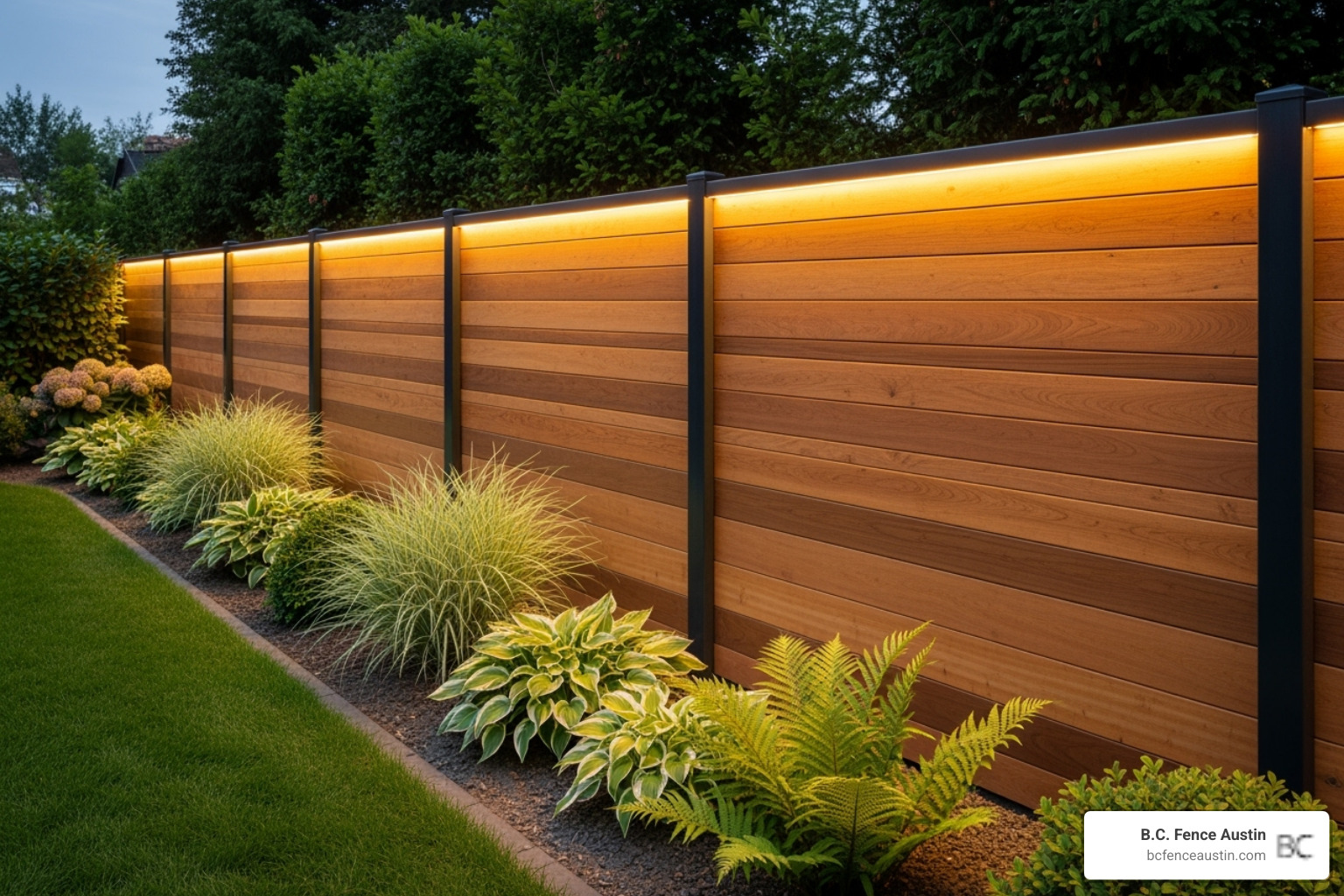
Creative wood fence ideas with a contemporary twist
The horizontal slat fence is the hallmark of modern fencing. Laying the planks sideways creates an optical illusion that makes yards feel wider and more expansive. Gaps can be left for a semi-private feel, or boards can be placed tightly for complete seclusion.
Mixing wood with metal is another popular modern approach. Combining the warmth of wood planks with the sleek, industrial look of black metal posts or frames creates a sophisticated contrast. The metal accents also add stability and require less maintenance. See examples in our Metal Wood Fence Projects.
A picture frame fence focuses on structure and finish. Each panel is framed on all four sides, creating a polished, gallery-quality look that adds superior strength and a refined aesthetic.
Unique patterns and textures for a statement fence
To make your fence a true architectural feature, consider creative patterns and textures.
A herringbone pattern, with its intricate arrangement of angled planks, creates a dynamic and sophisticated texture that provides complete privacy.
A chevron pattern uses planks cut at an angle to form a continuous “V” shape. This design offers excellent privacy with a sense of movement and energy.
For an artisanal feel, a basket weave design involves weaving thin wood strips to create a textured surface that is both rustic and refined.
A louvered fence adds functionality, with angled slats that provide privacy while allowing for airflow. Some designs even allow the slats to be adjusted for custom control over light and privacy.
Custom fence inserts are another way to personalize your fence. Incorporating decorative panels with geometric or nature-inspired designs can add a unique touch that reflects your style and becomes an instant conversation piece.
Customizing Your Fence: From Wood Type to Landscaping
The real magic of wood fencing happens when you start making it your own. From selecting the perfect wood species to choosing just the right stain color to integrating beautiful landscaping, every decision shapes how your fence looks and performs for years to come.
Choosing the Right Wood Species
Not all wood is created equal, and choosing the right species is one of the most important decisions you’ll make. The wood you select affects everything from how your fence looks on day one to how much maintenance you’ll be doing five years down the road.
| Wood Species | Durability & Rot Resistance | Typical Look | Maintenance Needs |
|---|---|---|---|
| Cedar | Excellent natural resistance to rot, decay, and insects. | Light, reddish-brown, weathers to silvery-gray. | Low to moderate (stain/seal every 2-3 years) |
| Redwood | Superior natural resistance to rot, decay, and insects. | Rich reddish-brown, weathers to dark gray. | Low to moderate (stain/seal every 2-3 years) |
| Pressure-Treated Pine | Chemically treated to resist rot, decay, and insects. | Greenish tint, can be stained any color. | Moderate (stain/seal every 2-3 years) |
| Ipe | Extremely hard, dense, and naturally resistant to rot, insects, and fire. | Dark brown, ages to a beautiful silver patina. | Very low (can be left to weather or oiled annually) |
Cedar is a popular choice for wood fence ideas in Austin due to its natural resistance to rot and insects. It weathers to a beautiful silvery-gray, a look many homeowners desire. You can even learn How to Age Wood to achieve this look faster.
Redwood is a premium option with even better natural resistance and a rich, reddish-brown color. For a detailed comparison, see our guide: Cedar vs Redwood Fence.
For homeowners watching their budget, pressure-treated pine is a smart, practical option. It’s chemically treated for durability and can be stained or painted any color.
And then there’s Ipe—the overachiever of the wood world. This incredibly dense hardwood naturally resists rot, insects, and fire, offering unparalleled longevity with minimal maintenance.
Finishing Touches: Stains, Paints, and Decorative Elements
Once you’ve picked your wood, it’s time for the fun part—deciding how to finish it. This is where your personality really shines through and where simple wood fence ideas transform into something uniquely yours.
The big question we hear all the time is whether to stain or paint. Staining lets the natural grain of the wood show through, while painting offers unlimited color options for a clean, solid look. Both approaches protect your investment. For help deciding, read our guide: Should I Paint or Stain My Wood Fence?.
Beyond color, decorative toppers like a lattice extension or a custom cap can add personality. Solar lights are another fantastic addition, providing evening ambiance and security without increasing your electricity bill. Finally, a custom gate sets the tone for your outdoor space. Find inspiration in our Wood Fence Gate designs.
Integrating Your Fence with Landscaping
Here’s something we wish more homeowners realized: your fence isn’t just a boundary. It’s a canvas, a backdrop, and a partner to your landscaping. When you thoughtfully integrate plants and greenery with your fence, you create something truly special.
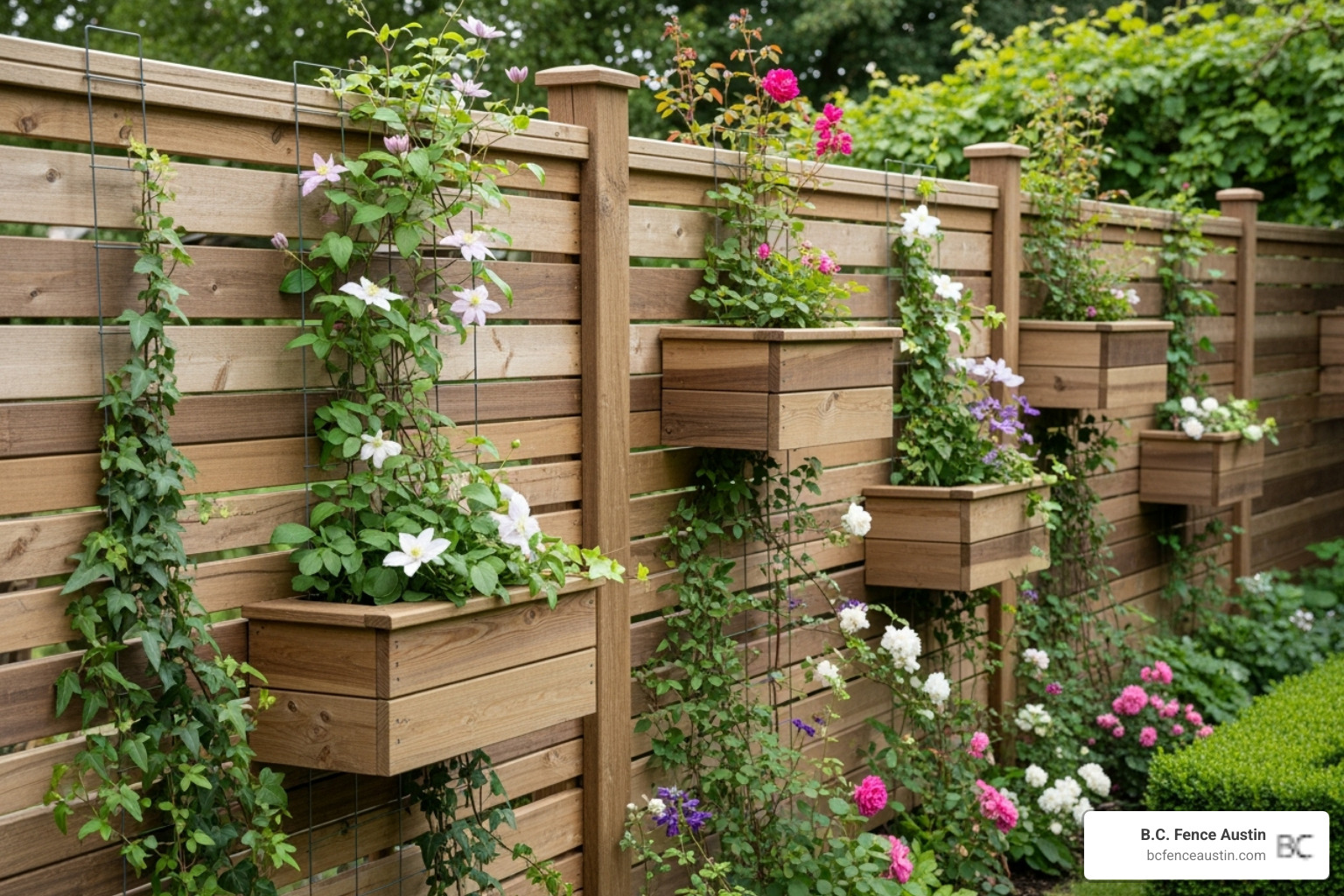
Planter boxes or raised beds along the fence base soften its look and provide a perfect spot for flowers or herbs.
Your fence can also serve as a trellis for climbing plants like clematis or climbing roses, creating a living wall of color and fragrance.
For smaller yards, vertical gardens attached to the fence create a lush garden wall without using ground space.
Use your fence as a backdrop to make your plantings pop. A dark stain can highlight bright green foliage, while a lighter fence creates a soft, cottage feel. This thoughtful landscaping ties your whole yard together.
Practical Guide: Installation, Maintenance, and Budgeting
Choosing the perfect wood fence ideas is exciting, but understanding the practical side—keeping your fence looking great, deciding who should install it, and knowing what factors affect your project—ensures your investment truly stands the test of time.
Wood Fence Maintenance and Common Repairs
A little TLC will keep your wood fence looking great for years.
Regular cleaning is key. Annually, scrub your fence with mild soap and a soft brush to remove dirt and mildew. A pressure washer can be used for stubborn grime, but be careful not to damage the wood. Learn more with our guide on How to Clean a Wood Fence.
Inspect your fence twice a year, in spring and fall. Look for rot, insect damage, loose hardware, or wobbly posts. Catching issues early prevents costly repairs.
To protect your fence from Austin’s intense sun and humidity, plan to reseal or restain every 2-3 years. This protective layer shields the wood from UV damage and moisture.
Even with diligent care, common issues can pop up. The good news? Wood fences are relatively easy to repair. A single damaged board can usually be swapped out. For detailed repair guidance, check out the Best Way to Fix a Wooden Fence.
DIY Projects vs. Professional Installation
The DIY versus professional installation question is one we hear all the time, and the answer depends on your skills, time, and the complexity of your chosen design.
Some wood fence ideas are more DIY-friendly than others. Building a fence with pallets, for example, can be a fun weekend project. If you’re feeling adventurous, our guide on Building a Fence with Pallets walks you through the process.
That said, fence building requires specific skills, tools, and precision. One crooked post can throw off your entire fence line. For most homeowners, especially those tackling complex designs, professional installation makes life so much easier. Our team at B.C. Fence Austin brings expertise, quality craftsmanship, and efficiency to every project. We understand Austin’s soil conditions and local building codes. Professional installation saves you time, prevents costly mistakes, and ensures your fence looks great and lasts for years. Learn more about our Wood Fence Installation services.
Factors That Influence Your Fence Project
Several important factors shape your wood fence project.
Material choices significantly impact your project. The wood species, hardware quality, fence height, and total linear footage all play a role in the overall scope.
Design complexity matters. A straightforward privacy fence is less labor-intensive than a custom herringbone pattern with mixed materials.
The long-term value of a quality wood fence shouldn’t be underestimated. A well-designed, expertly installed fence dramatically improves curb appeal and can increase your home’s market value.
Austin’s climate deserves special consideration. Our intense sun and heat demand woods with natural resistance to rot, like cedar and redwood. Proper sealing is absolutely necessary to protect your investment.
Finally, never overlook property lines and local regulations. Always verify your exact property boundaries and check local and HOA rules before installation.
Frequently Asked Questions about Wood Fences
We talk with Austin homeowners every day about their fencing projects, and certain questions come up again and again. Let’s tackle the big ones so you can move forward with confidence on your wood fence ideas.
What is the most durable type of wood for a fence?
The most durable woods have natural protection against the elements. Redwood and Cedar are the classic champions of durability, containing natural oils that fight off rot and insects. For homeowners who want the absolute toughest option, Ipe is in a league of its own, naturally resisting rot, insects, and even fire. If you’re working with a tighter budget, Pressure-Treated Pine is a smart, cost-effective choice that performs beautifully in our climate. For a detailed comparison, check out our guide on Cedar vs Redwood Fence: The Ultimate Guide to Wood Durability.
How can I make my wood fence more private?
Privacy is often the number one reason homeowners invest in a fence. The board-on-board design is our go-to for maximum privacy, as its overlapping pickets eliminate every gap. Lock board fences offer similar total seclusion with tongue-and-groove construction. Simply building taller is another effective method, where local regulations allow. You can also add a lattice topper for extra height or use landscaping like dense shrubs to create a natural, layered barrier.
Are wood fences an eco-friendly option?
Yes, wood fences are one of the most environmentally responsible choices you can make. First, wood is a renewable resource. When you choose FSC-certified wood, you’re supporting responsibly managed forests. Unlike plastic, wood is biodegradable and will naturally decompose at the end of its long life. The production of wood fencing also requires significantly less energy than manufacturing vinyl or metal, resulting in a smaller carbon footprint.
Conclusion
We hope this guide has given you plenty of inspiration for your next project. Whether you’ve fallen in love with the classic appeal of a white picket fence or you’re drawn to the clean, modern lines of a horizontal slat design, one thing is clear: wood fence ideas offer something truly special for every home and every homeowner.
What makes wood fencing so remarkable is how it combines form and function so effortlessly. You’re not just putting up a boundary—you’re creating a backdrop for memories, a shield for privacy, and a statement piece that adds real value to your property. Choosing wood is also a choice for sustainability, making it an investment that’s good for your home and the environment.
At B.C. Fence Austin, we’ve spent years helping homeowners throughout Austin, Cedar Park, Leander, Round Rock, and Georgetown turn their wood fence ideas into reality. We understand the unique challenges of our Texas climate and know which woods and finishes will stand the test of time. We believe a fence should improve your daily life, give you peace of mind, and make you smile every time you pull into your driveway.
Ready to start your fence journey? We’d love to hear about your vision and show you how we can bring it to life. Contact us for your professional wood fence installation and let’s create something beautiful together!
